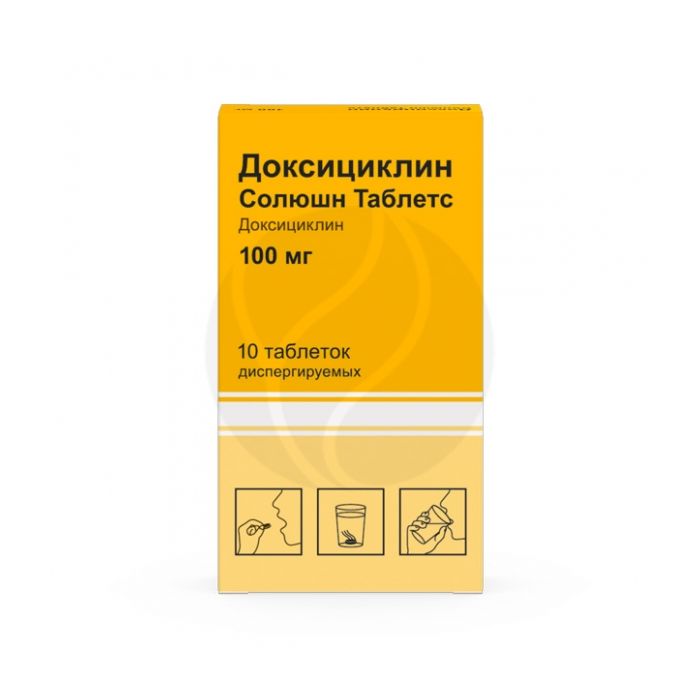Doxycycline Solution Tablets dispersible tablets 100mg, No. 10
Expiration Date: 05/2027
Russian Pharmacy name:
Доксициклин Солюшн Таблетс таблетки диспергируемые 100мг, №10
Adults are prescribed inside 200 mg / day on the first day of treatment, on the following days - 100-200 mg / day. Frequency rate of admission - 1-2 times / day. For children over 8 years old and weighing more than 50 kg, the daily oral dose is 4 mg / kg on the first day of treatment. In the following days - 2-4 mg / kg / day, depending on the severity of the clinical course of the disease.
Maximum doses for adults: for oral administration - 300 mg / day or 600 mg / day (depending on the etiology of the pathogen);
Dispersible tablets from gray-yellow or light yellow to brown-yellow, interspersed, oval, biconvex, with a risk.
1 tab.
doxycycline monohydrate 104 mg,
which corresponds to the content of doxycycline 100 mg
Excipients: lactose monohydrate - 140.8 mg, microcrystalline cellulose - 96 mg, low-substituted hyprolose - 29.25 mg, sodium saccharinate - 10 mg, hypromellose - 5.85 mg, magnesium stearate - 3.12 mg, colloidal silicon dioxide - 0.98 mg.
Pregnancy,
children under 8 years of age (the possibility of the formation of insoluble complexes with calcium in the bone skeleton, enamel and dentin of the teeth),
hypersensitivity to tetracyclines,
porphyria,
severe liver failure
leukopenia,
lactation period,
pharmachologic effect
Semi-synthetic antibiotic of the tetracyclines group of broad spectrum of action. It has a bacteriostatic effect by suppressing the protein synthesis of pathogens.
Active against aerobic gram-positive bacteria: Staphylococcus spp. (including strains producing penicillinase), Streptococcus spp. (including Streptococcus pneumoniae), Bacillus anthracis, Listeria monocytogenes; anaerobic bacteria: Clostridium spp.
Doxycycline is also active against aerobic gram-negative bacteria: Neisseria gonorrhoeae, Escherichia coli, Shigella spp., Salmonella spp., Enterobacter spp., Klebsiella spp., Bordetella pertussis, as well as against Rickettsia spp., Treponema spp., Treponema spp. and Chlamydia spp.
Pseudomonas aeruginosa, Proteus spp., Serratia spp., Most strains of Bacteroides fragilis are resistant to doxycycline.
Pharmacokinetics
After oral administration, it is rapidly and almost completely absorbed from the gastrointestinal tract. Food intake does not significantly affect the absorption of doxycycline. It is widely distributed in tissues and body fluids. Plasma protein binding is 80-95%. T1 / 2 is 12-22 hours. It is excreted in the urine unchanged (40%), but the main part of the dose is excreted unchanged in the feces due to the secretion of bile.
Side effect
From the digestive system: nausea, vomiting, anorexia, abdominal pain, diarrhea, constipation, dysphagia, glossitis, esophagitis, a transient increase in the blood levels of hepatic transaminases, alkaline phosphatase, bilirubin.
From the hematopoietic system: neutropenia, thrombocytopenia, hemolytic anemia.
Allergic reactions: skin rash, itching, eosinophilia; rarely - Quincke's edema, photosensitivity.
Others: an increase in residual nitrogen, candidiasis, intestinal dysbiosis, discoloration of teeth in children.
Application during pregnancy and lactation
Doxycycline is contraindicated during pregnancy and lactation. Doxycycline crosses the placental barrier. May cause long-term discoloration of teeth, enamel hypoplasia, suppression of the growth of fetal skeletal bones, as well as the development of fatty liver infiltration.
If necessary, use during lactation should stop breastfeeding.
Application for violations of liver function
Contraindicated in severe hepatic impairment. Doxycycline is used with caution in case of liver dysfunction.
Application for impaired renal function
In case of impaired renal function, dose adjustment is not required.
Application in children
Doxycycline is not used in children under 8 years of age, because tetracyclines (including doxycycline) cause long-term discoloration of teeth, enamel hypoplasia and slowing of the longitudinal growth of skeletal bones in this category of patients.
special instructions
Doxycycline is used with caution in case of liver dysfunction. In case of impaired renal function, dose adjustment is not required.
To prevent local irritating effects (esophagitis, gastritis, ulceration of the gastrointestinal tract), it is recommended to take it during the daytime with a large amount of liquid, food or milk. In connection with the possible development of photosensitization, it is necessary to limit insolation during treatment and for 4-5 days after it.
Doxycycline is not used in children under 8 years of age, because tetracyclines (including doxycycline) cause long-term discoloration of teeth, enamel hypoplasia and slowing of the longitudinal growth of skeletal bones in this category of patients.
Doxycycline solution for intravenous administration should be used no later than 72 hours after its preparation.
Drug interactions
Preparations containing metal ions (antacids, preparations containing iron, magnesium, calcium) form inactive chelates with doxycycline, and therefore it is necessary to avoid their simultaneous administration.
With simultaneous use with barbiturates, carbamazepine, phenytoin, the concentration of doxycycline in the blood plasma decreases due to the induction of microsomal liver enzymes, which may be the reason for a decrease in its antibacterial effect.
It is necessary to avoid the combination with penicillins, cephalosporins, which have a bactericidal effect and are antagonists of bacteriostatic antibiotics (including doxycycline).
Doxycycline absorption is reduced by cholestyramine and colestipol (observe the interval between doses of at least 3 hours).
Due to the suppression of the intestinal microflora, doxycycline reduces the prothrombin index, which requires a dose adjustment of indirect anticoagulants.
Taking doxycycline reduces the reliability of contraception and increases the incidence of breakthrough bleeding while taking estrogen-containing oral contraceptives.
The simultaneous use of retinol increases intracranial pressure.

